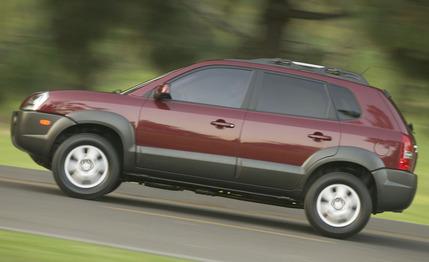
 First Drive Review
First Drive Review
According to Hyundai, the small-SUV segment will grow faster than any other sector of the market over the next four years. It may be the fastest-growing segment, but it isn't the most exciting. Except for the turbocharged version of the Subaru Forester, the 2.5XT, a 2004 5Best Trucks winner, the entire small-SUV category lacks the performance and panache to which enthusiasts gravitate. But Hyundai doesn't intend to redefine the category with a performance sport-ute. Instead, the company will forgo enthusiasts and lure buyers with the same bait used successfully by its car line: low price, newfound quality, and that reassuring warranty (10 years/100,000 miles) that absolves many sins. We went to the Korean island of Cheju to see what's up.
Positioned below and slightly smaller than the Sonata-based Santa Fe, the tastefully styled, brand-new Tucson is built on a strengthened and stretched Elantra platform that provides a surprising amount of interior space. The Tucson is remarkably roomy and actually has nearly two more cubic feet of passenger space than its older brother, the Santa Fe. It's only in the cargo area that the longer Santa Fe trumps the Tucson. Clearly, there is some overlap between the two utes, but Hyundai recognizes the conflict and intends to enlarge the next-gen Santa Fe, leaving the bottom rung to the Tucson.
Interior fit and finish is certainly not bottom rung. Tolerances are tight, and the controls have a satisfying feel. However, aside from a stylish piece of aluminum trim surrounding the radio and climate controls, interior plastics are of the hard and shiny variety that most manufacturers gave up on during the Reagan administration.
Like all little brothers, the Tucson enters the world with a few hand-me-downs. The base engine is the Elantra's 2.0-liter four-cylinder, with a five-speed manual standard and an optional four-speed automatic with manumatic shifting. Although final figures were not available, Hyundai estimates the 2.0-liter will make 140 horsepower and 136 pound-feet of torque. (No four-cylinder models were on hand for our drive.)
For those who want more power, there is an optional 2.7-liter V-6 straight out of the Santa Fe. Burdened with nearly 3600 pounds on all-wheel-drive models, the estimated 173 horsepower and 178 pound-feet of torque fight a constant battle against an obstinate four-speed automatic transmission that can never decide what gear to be in. Upshifts and downshifts occur almost randomly-you're never in the right gear, only a less wrong one. Hyundai's Shiftronic does allow the driver to manually select gears in the gate, but try as you might, requests seem to fall on deaf ears. Hyundai needs to put an extra cog in the tranny or offer the more powerful 200-hp, 3.5-liter V-6 option from the Santa Fe if it wants to make the Tucson run with the 200-hp V-6 in the Ford Escape and Mazda Tribute.
Once the Tucson is up to speed, it offers a quiet, serene ride that, unlike the Santa Fe's, does not err on the side of softness. Ride motions are damped quickly, and the springs balance handling and comfort admirably. A quick jaunt down a rutted dirt road revealed excellent isolation from the rough stuff and a quiver-free structure. The feeling of substance is no illusion as the Tucson weighs more than a Honda CR-V or a Toyota RAV4. Throw the Tucson into a series of switchbacks, and its mass conspires to sap the fun from any great road. Handling is deliberate and safe in both front- and all-wheel-drive variants, but enthusiasts will prefer the deft and comparatively lithe chassis of the RAV4 or Escape/Tribute twins. When hustled, the Tucson never cracks a smile, and consequently, neither will the driver.
What will make safety-conscious buyers smile is the optional BorgWarner Electronic Interactive Torque Management all-wheel-drive system that sends power to the rear wheels when front-wheel slip is detected. The system is seamless in operation and faster-acting than the Escape's all-wheel drive. Other safety features include standard side and curtain airbags on GL, GLS, and LX models and optional traction control on GLS and LX models. Hyundai claims to have worked hard on protecting occupants in a collision. How the Tucson will fare in the Insurance Institute for Highway Safety's 40-mph offset crash test remains to be seen, and Hyundai is hoping to receive a five-star rating from NHTSA's less-severe 35-mph full-frontal impact.
Hyundai estimates the Tucson will start at about $17,000 for the base GL model with the four-cylinder. GLS and LX models come standard with the V-6 and start at about $22,000. The LX comes with leather and an AM-FM radio with a cassette player and six-CD in-dash changer.
The Tucson brings to the segment value, a solid structure, and a reasonably quiet driving experience, but there isn't a whole lot to love. None of Hyundai's product trades on any sort of emotional attraction, yet they continue to make inroads into our market. The Tucson has enough going for it to keep Hyundai sales growing, but enthusiasts will have to keep waiting for something to lust over.